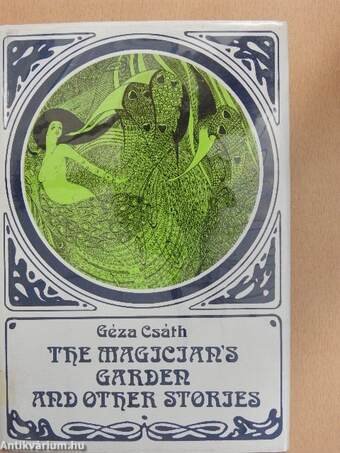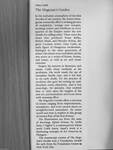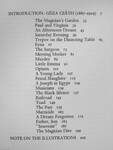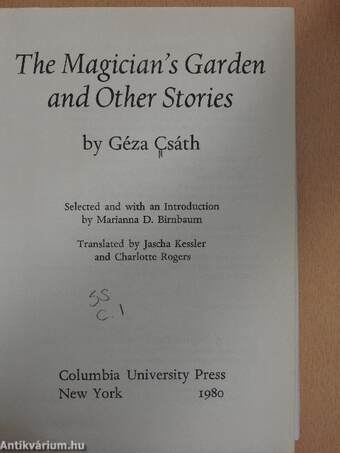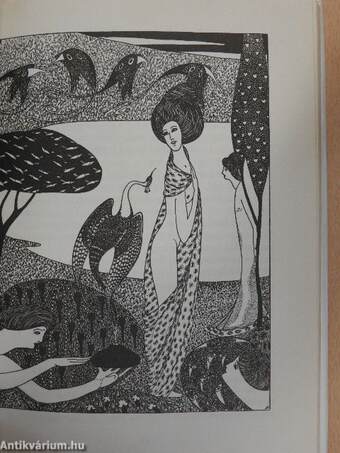1.077.075
kiadvánnyal nyújtjuk Magyarország legnagyobb antikvár könyv-kínálatát

VISSZA
A TETEJÉRE
JAVASLATOKÉszre-
vételek
The Magician's Garden and Other Stories
| Kiadó: | Columbia University Press |
|---|---|
| Kiadás helye: | New York-London |
| Kiadás éve: | |
| Kötés típusa: | Vászon |
| Oldalszám: | 205 oldal |
| Sorozatcím: | |
| Kötetszám: | |
| Nyelv: | Angol |
| Méret: | 19 cm x 13 cm |
| ISBN: | 0-231-04732-0 |
| Megjegyzés: | Fekete-fehér illusztrációkkal. |
naponta értesítjük a beérkező friss
kiadványokról
naponta értesítjük a beérkező friss
kiadványokról
Fülszöveg
Geza Csath
The Magician's Garden
In the turbulent atmosphere of the first
decades of our century, the Austro-Hun-
garian monarchy offers a striking picture
of complexity: strange new energies,
seething, restive, and rebellious, in every
quarter of the Empire under the low
clouds of a stifling order. Those were the
times that produced Franz Kafka,
Robert Musil, and Miroslav Krleza, the
great Croatian writer. Geza Csath, an
early figure of Hungarian modernism,
belonged to the same generation of
artists. His talents were multifold, and he
was active as a writer of fiction, drama,
and essays, as well as art and music
criticism.
Despite his interest in literature and
music, Csath chose medicine as his
profession. His work made the use of
morphine fatally easy, and it led him
to an early death. Yet the practice of
medicine also gave his writing its cool,
detached, ironic objectivity. And it was
neurology, his specialty, that enabled
him to seize upon the... Tovább
Fülszöveg
Geza Csath
The Magician's Garden
In the turbulent atmosphere of the first
decades of our century, the Austro-Hun-
garian monarchy offers a striking picture
of complexity: strange new energies,
seething, restive, and rebellious, in every
quarter of the Empire under the low
clouds of a stifling order. Those were the
times that produced Franz Kafka,
Robert Musil, and Miroslav Krleza, the
great Croatian writer. Geza Csath, an
early figure of Hungarian modernism,
belonged to the same generation of
artists. His talents were multifold, and he
was active as a writer of fiction, drama,
and essays, as well as art and music
criticism.
Despite his interest in literature and
music, Csath chose medicine as his
profession. His work made the use of
morphine fatally easy, and it led him
to an early death. Yet the practice of
medicine also gave his writing its cool,
detached, ironic objectivity. And it was
neurology, his specialty, that enabled
him to seize upon the insights of the
new art, psychoanalysis, and to use them
with stunning effect.
The Magician's Garden offers a selection
of stories ranging from impressionistic,
metaphoric, and even surreal pieces to
straightforward naturalism. An entire
world and time is implicit in this group
of twenty-four of his best fictions.
The illustrations are from the suite
of drawings, Opium Dreams, by Attila
Sassy ("Aiglet), a contemporary whose
work Csath knew. Sassy's work is a
fascinating example of Art Nouveau in
Hungary.
The manuscript version of The Magi-
cian's Garden won a Translation Award
for 1978, from the Translation Center in
New York City. Vissza
Géza Csáth
Géza Csáth műveinek az Antikvarium.hu-n kapható vagy előjegyezhető listáját itt tekintheti meg: Géza Csáth könyvek, művekMegvásárolható példányok
Nincs megvásárolható példány
A könyv összes megrendelhető példánya elfogyott. Ha kívánja, előjegyezheti a könyvet, és amint a könyv egy újabb példánya elérhető lesz, értesítjük.



